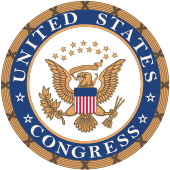| Invention Secrecy Act of 1951 | |
|---|---|
 | |
| United States Congress | |
| |
| Citation | 66 Stat. 3 |
| Enacted | February 1, 1952 |
| Bill citation | Pub. L. 82–256, 66 Stat. 3, enacted February 1, 1952 |
| United States patent law |
|---|
| Legislation |
| Types of patent claims |
| Procedures |
| Other topics |
| This article is part of a series on the |
| United States Code |
|---|
 |
|
|
The Invention Secrecy Act of 1951 (Pub. L. 82–256, 66 Stat. 3, enacted February 1, 1952, codified at 35 U.S.C. ch. 17) is a body of United States federal law designed to prevent disclosure of new inventions and technologies that, in the opinion of selected federal agencies, present an alleged threat to the economic stability or national security of the United States.
The Invention Secret Act allows the United States government to classify ideas and patents under "Secrecy Orders", which indefinitely restrict public knowledge of them.[1] The law applies to all inventions in the United States regardless of what the idea or invention is, if a patent is applied for or granted.[2]35 U.S.C. § 181 All patents filed within the United States are required to be reviewed, and thousands of ideas and inventions are manually reviewed every year.[2][3] Any Federal government agency with "classifying powers" may request any patent be restricted under the Invention Secrecy Act.[4]
Ideas restricted by the Invention Secrecy Act's Secrecy Orders can be prohibited from any public disclosure; sales to any party except the United States military industry or exports to other nations can be prohibited; and can even be sealed from the public as classified.[5][6][1] Any appeals are limited to the United States Federal agency that itself restricted the ideas.[5] The United States Patent and Trademark Office has investigated the possibility of restricting new technologies if those new ideas may be disruptive to existing industries.[7] The Invention Secrecy Act has been criticized for lack of oversight and impacts on future scientific research by inventors, industry, attorneys and academics.[1][5][7][8]
- ^ a b c Cite error: The named reference
Saltz Texas A&M February 22, 2022was invoked but never defined (see the help page). - ^ a b Cite error: The named reference
Locke Indiana 2019was invoked but never defined (see the help page). - ^ Cite error: The named reference
Shulz Wired April 13, 2013was invoked but never defined (see the help page). - ^ Cite error: The named reference
Sanders Reason 1981was invoked but never defined (see the help page). - ^ a b c Cite error: The named reference
Dilawar Slate May 9, 2018was invoked but never defined (see the help page). - ^ Cite error: The named reference
Gross NBER July 1, 2019was invoked but never defined (see the help page). - ^ a b Cite error: The named reference
CEPR manifold impacts April 19, 2022was invoked but never defined (see the help page). - ^ Cite error: The named reference
IJIO Patents study December 23, 2023was invoked but never defined (see the help page).